INTRODUCTION TO WOODTURNING
Chapter 3: The tools
3.1 Introduction
The range of woodturning tools on the market today is enormous. Ashley
Iles, for example, produce 350 different woodturning tools. These are all
standard tools made in a range of sizes in carbon steel or high speed
steel. In addition a number of manufacturers are making some highly
specialised (and very expensive) tools, such as the Stewart System. Most
beginners, however, will only be able to afford a limited number of
standard tools so they will have to make some careful choices. My
suggestions for the minimum basic set of tools is given at the end of this
chapter.
But, before coming to the choice of tools the beginner needs to
understand the functions of the different types and the reasons for some
relatively subtle differences in shape and form. The difference between
carbon steel and high speed steel also needs to be understood.
When I started turning at the beginning of the eighties only carbon
steel tools were available, but since then high speed steel turning tools
have become ubiquitous. High speed steel, which is harder than carbon
steel, was originally developed to enable higher cutting speeds to be used
when machining metal. Because of this high speed steel tools retain their
edge longer on wood.
Nevertheless, each type of steel has its advantages and disadvantages.
These are discussed later in this chapter. There are three principal types
of tool: scrapers, chisels, and gouges. Gouges can be sub-divided into
three further types: bowl gouges, spindle gouges, and roughing out gouges.
Chisels and gouges are usually described as cutting tools, because they
are designed to sever rather than break, or tear, the wood fibres. In
contrast scrapers are often perceived as crude tools which simply tear out
a shaving. However, when employed with care, and the correct technique,
scrapers can be used to sever the fibres and leave a good finish. It must
be pointed out, too, that chisels can, on occasion, be used for scraping.
However, there is a clear distinction which can be made between chisels
and gouges on the one hand and scrapers on the other. This concerns the
attitude in which they are used. When employed in the cutting mode chisels
and gouges are used with the bevel rubbing and the wood moving onto the
edge of the tool (see also Chapter 6). In contrast scrapers must never be
used with the bevel rubbing and the edge must be trailing. Except in very
special circumstances this means that a scraper must be used with the tool
pointing downwards. (See Diagram 3.1) If a chisel is used for scraping it
must be held in the same attitude as a scraper, that is, pointing
downwards.
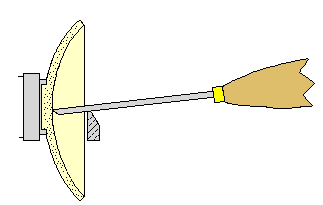
Diagram 3.1 Attitude of scraper in use
These distinctions will become clearer when the ways the tools are used
are described in the chapters which follow. The description of the shapes
of the tools will also help to clarify matters.
3.2 Scrapers
Scrapers are mostly made from rectangular bar and are usually ground
with a large bevel angle. The size of the bevel angle is not critical,
however, and some turners may make it relatively small. Like a chisel, the
cutting edge of a scraper can be skewed, but it can also be a variety of
other shapes. Some of the most common, which a beginner may wish to use,
are shown in Diagram 3.2. They can be made from either carbon steel or
high speed steel and the same shapes are used in both materials.
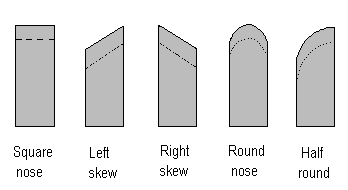
Diagram 3.2 Some shapes for scrapers
3.3 Chisels
Like scrapers chisels are usually made from rectangular bar but the
bevels are ground differently. Chisels usually have double bevels, and the
bevel angles are smaller than those normally used on scrapers (see Diagram
3.3).
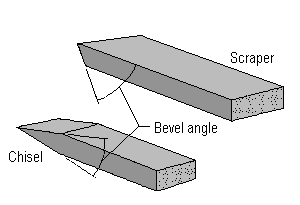
Diagram 3.3 Bevels on chisels and scrapers
The cutting edge of a chisel can either be ground square across or it
can be skewed (see Diagram 3.4).
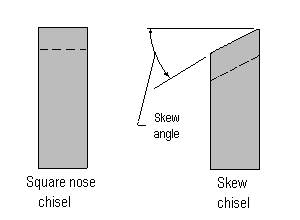
Diagram 3.4 Square and skewed edge chisels
Carbon steel chisels have always been made with a rectangular
cross-section. High speed steel skew chisels can also have a rectangular
cross-section. Some, however, are made slightly oval in section with one
edge rounded (see Diagram 3.5, section A-A). In the smaller sizes this can
make them a little flimsy, particularly when they are made overlong. Until
recently the cutting edge of a skew chisel was always ground so that it
was straight (as in Diagram 3.4) but in recent years some turners have
made it curved (as in Diagram 3.5).
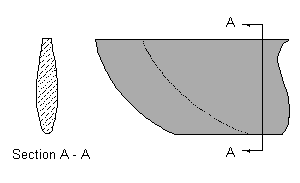
Diagram 3.5 Oval section HSS chisel with curved cutting edge
3.4 Parting tools
Parting tools are narrow chisels. In principle, as their name suggests,
they are used for separating the waste material from either end of the
finished piece of work. In practice they have a number of other uses. They
come in a variety of shapes and sizes, some of which are shown in diagram
3.6.
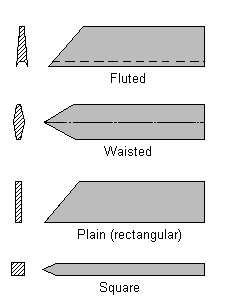
Diagram 3.6 Parting tools
3.5 Bowl gouges
Because bowl gouges are often used with a long overhang between the
cutting edge and the rest they need to be stiff and strong so that they
will not bend or flex in use. Books written before high speed steel came
into use refer to the ‘long and strong’ bowl gouge. This is a
carbon steel gouge which has a deep ‘U’ section. It has been
superseded by the high speed steel bowl gouge which is made by milling a
flute into round bar. This gives a very different cross-section (see
Diagram 3.7).
The long and strong carbon steel bowl gouges were ground so that the
cutting edge was square to the axis of the tool, as shown in Diagram 3.7.
Also shown in this diagram is the shape of the a high speed steel bowl
gouge. It can be seen that in this case the wings are ground back. The way
this is achieved is described under sharpening below. (See Section 4.4)
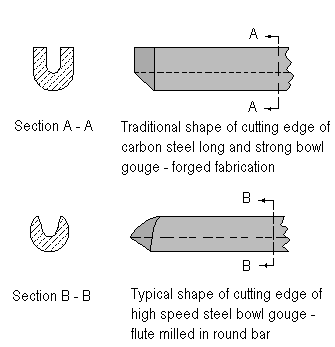
Diagram 3.7 Bowl gouges
Sizes normally refer to widths but high speed steel bowl gouges are
measured in a very peculiar way: from the inside of the flute to the
outside of the bar (see Diagram 3.8). Although these tools have only been
available for a few years the reason for the way in which they are
measured seems to have been lost in the mists of time. Anyway, the
unfortunate result of this system is that, in effect, there are no
standard sizes. Differences in the size of the flute in relation to the
diameter of the bar can lead to very different gouges with the same
nominal size. Note that it is the size of the flute which really determines the size of the tool. The diameter of the bar determines the strength of the tool.
There are in practice quite substantial differences between
manufacturers and I suggest that when building up a set of bowl gouges an
attempt should be made to stick to a single brand.
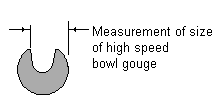
Diagram 3.8 Measurement of size of HSS bowl gouge
3.6 Spindle gouges
Carbon steel spindle gouges are forged from flat bar to form the
cross-section shown in Diagram 3.9. High speed steel spindle gouges can be
produced in the same way but they are more commonly made by milling the
flute from round bar in a similar way to bowl gouges. The flutes in
spindle gouges are, however, much larger than those in bowl gouges
relative to the size of the bar. This provides a slimmer tool which can
enter the more restricted spaces encountered in spindle turning. The shape
of the cutting edge of a spindle gouge has traditionally been described as
a a fingernail shape, that is, half an ellipse (see Diagram 3.9).
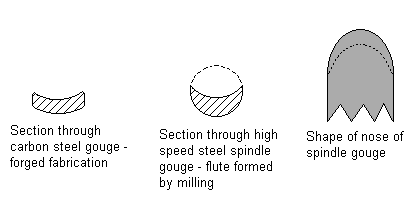
Diagram 3.9 Shape of spindle gouge
3.7 Roughing-out gouges
Roughing gouges are used in the preliminary stages of spindle turning
(as described in Chapter 9). They are normally much larger than bowl or
spindle gouges and it is important to note that they should never be used
to shape bowls. They are made by forging or pressing flat bar into a
half-round section. Some manufacturers of high speed steel roughing gouges
extend the wings a little to form a ‘U’ section which flares out
slightly (see Diagram 3.10).
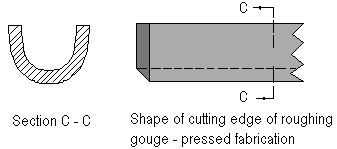
Diagram 3.10 Shape of roughing gouge
3.8 Interchangeability of gouges
It is quite common today to find a high speed steel bowl gouge used to
perform the function of a spindle gouge. I do this quite frequently
myself. The reason for this is that when they are made from high speed
steel there is not a great deal of difference in the shape of the cutting
edge of the two types of gouges. But there is one important difference
which should be noted: for a given size of cutting tip (which is related
to the size of the tool) a bowl gouge is very much stronger than a spindle
gouge. As a consequence, although a bowl gouge may be used for spindle
turning a spindle gouge should not (normally) be used for bowl turning.
3.9 The different types of steel
It is often said that high speed steel tools are easier to sharpen (on a
grinding wheel) than carbon steel. The justification given for this
statement is that it is less easy to overheat and soften the edge of a
high speed steel tool. Although that is true, they also take longer to
sharpen (because they are harder) which can make it more difficult to get
the desired shape. It is also said that high speed steel tools last
longer. This , too, is true, but they are also a lot more expensive. And
how long does one want a tool to last? I have been using my 1 1/4in carbon
steel skew chisel for eighteen years and I still have more than half the
length left.
So, we come to a contentious point. Nowadays, some turners will only use
high speed steel tools, and some stockists do not sell carbon steel tools.
Nevertheless, I always advise beginners to buy a mixture of high speed and
carbon steel tools.
Because of the edge retaining properties of high speed steel I certainly
believe it is best for bowl and spindle gouges. The high speed steel bowl
gouges are also made from round bar which also provides a better shape
than the old, forged, carbon steel forms. For skew chisels and scrapers I
find that the edge retaining qualities of high speed steel are not so
important. So, for these, I recommend carbon steel; they are easier to
sharpen, they are cheaper, and they will last as long as necessary.
3.10 The form of the bevel
The bevel on cutting tools, ie chisels, gouges and parting tools, must
be the correct shape: either hollow ground (concave) or flat, it should
never be rounded (convex). If the bevel on a tool is rounded it will very
difficult, if not impossible, to use it without digging in. (The reasons
for this are explained in detail in Chapter 6.) So it is vitally important
to get the bevel right. Many novice turners get it wrong; I have seen a
lot of tools it would be impossible to use successfully.
There is also the question of the bevel angle to consider. The size of
bevel angles is by no means as critical as many pundits would suggest. One
aspect of this is that bevel angles are often expressed as a precise
number of degrees. In practice it is pretty well impossible to grind, and
to measure, to that degree of accuracy. It certainly is not necessary.
There is wide disagreement among skilled turners regarding the bevel
angles for specific tools. For example one book on my shelves says that
the bevel angle on a skew chisel should be 25° (that is 12.5° on
each side!) and another suggests that it should be 45°. The truth
of the matter, probably, is that skew chisels can be used successfully
with bevel angles anywhere between these two figures.
A wide range of bevel angles can be used on bowl gouges without
experiencing problems although the most satisfactory angle tends to depend
on circumstances. For example, it may be necessary to use a bowl gouge
with a large bevel angle (eg 60°) to turn the bottom of the inside of
a deep bowl. However, a bevel angle of 40° to 45° will serve for
many circumstances. Other angles can be experimented with when the turner
feels inclined. In general slightly smaller bevel angles can be
recommended for spindle gouges. If the spindle gouge is to be used for
cutting beads then a small bevel angle is required so that the tool can be
introduced into small spaces.
Generally speaking, however, I believe that tools with relatively large
bevel angles are easier for the novice to use than the reverse. Tools with
small bevel angles tend to be ‘grabby’, that is to say they have
a tendency to bite into the wood. This is particularly true of chisels. In
my view most manufacturers supply chisels with the bevel ground to too
small an angle. For my students I grind the chisels to a bevel angle of
around 45 degrees. But any angle between 35 and 45 degrees will be
satisfactory.
3.11 The minimum kit of tools
I would say that the minimum number of tools required to start with is
ten. I bought a boxed set of that number when I started turning, more by
luck than judgement, and I have never found any reason to think that was a
wrong decision. The beginners set of mixed high speed and carbon steel
tools I would recommend is made up as follows:
High speed steel
- 3/8 in bowl gouge
- 1/4 in bowl gouge
- 1/2 in spindle gouge
- 1/4 in spindle gouge
Carbon steel
- 3/4 in roughing gouge
- 11/4 in skew chisel
- 11/4 in square nose scraper
- 1/2 in square nose scraper
- 3/4 in round nose scraper
- 3/8 in square beading and parting tool
- 1/8 in plain parting tool
It will have been noticed that this list contains 11 tools. This is
because have added the 1/8 plain parting tool to my original list - it is
a very useful tool. My choice of a carbon steel skew chisel may surprise
and irritate a lot of turners. The oval, high speed steel, skew chisel has
many devotees. I can only say that I am not enthralled with it, but that
is probably a personal idiosyncrasy.
|